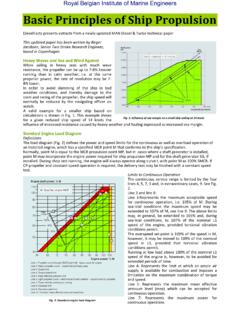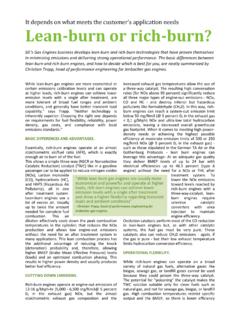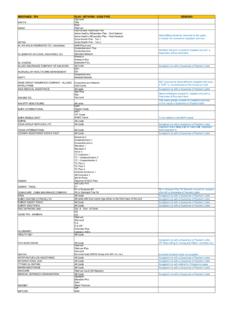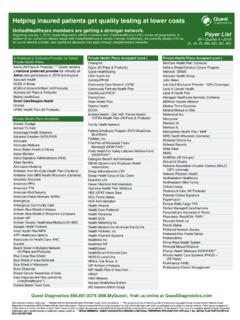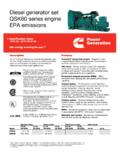Transcription of The ship’s electrical network, engine control and automation
1 electrical power in ships is usually produced by a synchronousgenerator. Given the essential nature of electrical poweronboard ship , several means are used to assure its continuousavailability. The main switchboard is divided into two or moresections. Also necessary are a switchboard supplied by anemergency generator as well as an uninterrupted (batterysecured) power supply (Figs. 2 and 3), both for reasons of safetyand to ensure the electrical networkThe first step is to define the ship type. It goes without saying thatthe vessel s size and purpose are key factors when dimensioning theship s electrical network . The following illustrate the differingelectrical needs of different types of ship .
2 NCargo handling equipment plays a dominant role incontainerships, and defines the special power requirementcharacteristics of the electrical networknIn tankers, cargo pumps and possibly compressors are significantfactorsnIn passenger ships large electricity consumers are airconditioning, the galley equipment, stage equipment andlighting (also called hotel load) and the transverse thrusters formanoeuvring in portnIn ships with electric propulsion, the propulsion machineryitself is the dominating the choice of propulsion machinery and the classificationregulations have an impact on the design of the electrical rules of SOLAS (International Convention for the Safety ofLife at Sea), the flag state and the harbour authorities specify thebasic level of safety, while the classification societies mainly specifythe basic navigational regulations.
3 A redundant propulsion,unmanned engine room, a green ship , all set their of the electrical networkOnce the type of the propulsion machinery, diesel-mechanic ordiesel-electric, has been selected further clarifications and decisionshave to be made, examples of which are the following:nMaximum electrical power needed to be generated (the loadreservation is agreed with the customer).nGiven that information on the ship s electricity consumers canbe limited, load calculations are often based on relative valuescalculated from reference ships. Also, different ship operatingmodes (sailing, manoeuvring, loading, harbour, DP etc.) willaffect the load calculations.
4 It is important that the loadcalculations are updated while the ship is being built and thatthe final actual consumption information is received from theshipowner after the ship is size and numbernSelection of main voltage and frequencynVoltage drop calculationnShort circuit calculation and network selectivity and electrical networksNetwork supplied by an emergency generatorAn emergency diesel generator (EG) is used to provide mainelectrical power should the main source fail, for example as a resultof a emergency source must be self-contained and independentof the other engine room systems, with its own independentsystems for starting, fuel oil, lubrication oil, cooling andpreheating.
5 The consumers supplied by the EG as required by theregulations include emergency lighting, navigation andcommunication equipment, the steering gear, fire and sprinklerpumps, bilge pump, water tight doors and EG must also be able to start automatically if the mainsource of electrical power fails to supply the emergencyswitchboard. In this case the EG is automatically started andconnected to the emergency switchboard. The automatic startingsystem and the characteristics of the prime mover should be chosento ensure that the EG carries the required load as quickly as is safeand practicable, and within a maximum period of 45 services listed above are then automatically supplied fromthe emergency switchboard (due to interlocking of the EG andmain source breakers) ( ).
6 Uninterruptible power supply (UPS) networkWhere the emergency source of electrical power is a generator, thismust be provided with a transitional source of emergency electricalpower. The ship type defines the selected uninterruptible powersupply (UPS) circuit currentShip operation profilePropulsionHeavy consumersMain voltageTotal power requirementsFig. 1 Designing a ship s electrical network calls for a carefulbalance of various critical ship s electrical network , engine control and automationby Kari Valkeej rvi, Marine Technology, W rtsil CorporationRoyal Belgian Institute of Marine EngineersA battery or an uninterruptible power supply (UPS) must beprovided as a standby power supply with a capacity of 30 and safety aspects (required by class) define the use ofthe UPS, such as automation , navigation, radio and safetyannouncement equipment, emergency lighting, watertight doors, cruise applications and passenger accommodation (comfortrequirements)
7 Other systems commonly supplied by the UPS arecable TV, telephones, the onboard intercom system, casino, hoteland restaurant, and cash generator (SG) networkIn addition to auxiliary generators an electrical network may alsoconsist of shaft generators (SG) driven by the main engine . In someintallations shaft generators are used only for driving thrustersduring manoeuvring while in others they supply the ship snetwork. For this reason some interconnections are required toavoid overload or damage to the network . The following feedercombinations, for example, are prohibited:nIf the bus-tie breaker is closed, the SG breakers are interlockedin the open the SG breaker is closed, the bus-tie breaker is interlocked inthe open the bow thrusters breaker is closed, the SG breaker isinterlocked in the open synchronizing the SG in parallel with the diesel generator(DG), the DG breaker has to be open with a time and every auxiliary power station (switchboard) mustbe defined the SG is connected and supplying the ship s network , aconstant speed mode for the main engine must be selected.
8 Thismeans a pre-selected network constant speed mode, the propulsion must be controlled bypitch adjustments to the controllable pitch propeller (CPP). Themain engine can run the SG when this is disengaged from the mainpropulsion line by a clutch. In this case the main engine runs as anauxiliary engine , for example to feed large consumers duringloading or unloading in propulsionThe electrical network in a ship with traditional diesel-mechanicalpropulsion is called an auxiliary power station and is powered byan auxiliary auxiliary power station normally consists of three or four(minimum two) synchronous generators, two of which typicallyrun in parallel during sea 2 Low-voltage 690V network for auxiliary power station.
9 Diesel-mechanical the wide variety of ship operational conditions and loadvariations it is often a good idea to select different sizes ofgenerators (two small and two big, for example), although sucharrangements set higher demands on generator protection running big and small generators in parallel, an unexpectedstop of a bigger generator could create a blackout without a quickand well managed load reduction system ( two-step preferencetrips for non-essential consumers).Diesel-electric propulsionThe market share of diesel-electric propulsion systems in ships for awide range of uses has substantially increased in recent years. Dueto their flexibility and versatility, diesel-electric propulsion systemsare highly adaptable to a wide range of diesel-electric concept is gaining favour in newbuildings,especially the cruise ship this case the power to the propulsion machinery is suppliedby the same generators as supply the other electrical , the diesel engines are called the main engines (ME) and theclassification requirement must be followed as stipulated for typical applications, four or six equal-sized generators supplythe main switchboard.
10 These are connected symmetrically each sideof a bus-tie breaker (Fig. 3.). The overall solution will largelydepend on the increasing demand for reliability (redundancy) andthe desired level of power moversThe most common prime mover for generator applications is stillthe diesel engine . Smaller engines are installed with the generatoron a common baseframe. In larger diesel-electric applications bothhave their own baseframe and are connected with a engine speed controlThe governors used to control engine speed are usuallyhydraulic/mechanical or electronic. Electronic governors are usedin more complex applications. The speed governor controls theengine speed (generator frequency) and active load sharing eitherbyspeed droopor in anisochronous(zero droop) droopcontrol is still the most common method of engineload sharing.






